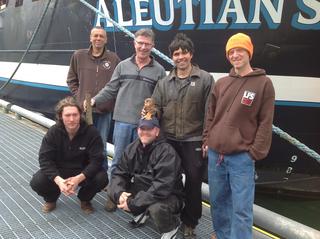Black Cod Boat Turns Up World War II "Bomb"

Thursday, July 19 2012
By the time he pulled up the mine, Jimmy Berg had caught as much metal as fish.
Berg is a deckhand on the Aleutian Sable, and he was hauling black cod pots just outside Unalaska one day in late June. He’d already found a 35 millimeter shell in his pot, so he wasn’t particularly surprised when he spotted this thing stuck to another pot a few hours later.
It was a hunk of rust the size, and color, of a brick. It seemed harmless enough – until it shocked him.
“It shocked me like three times," Berg says. "But it looked pretty cool so I just set it right between my legs as we kept hauling gear and smashing pots against the side of the boat.”
During a lull, the crew started playing around with Berg’s find. He handed it over to another deckhand, Dan Stickney, who left the Marines two years ago.
"I handed it to [Dan], as Cameron started cutting it open with a knife. We found out it was a bomb. And then he ran around the deck scared. Now the Marine is scared, because he has a bomb in his hand.”
The “bomb” appears to be a World War II landmine. I sent a picture of it to Grady May, a Navy researcher, for confirmation. Here's what May could tell me for sure: It's not a good idea to pick up ordnance.
“Yeah, you should never collect that," May says. "If you ever come across something that you don’t know what it is, you should leave it alone.”
Leaving it alone is exactly what the Navy’s done in Kodiak, Kiska, and Unalaska for the last 70 years. But it’s trying to remedy that now. May is in charge of a new program to find and catalog unexploded World War II ordnance in Alaska.
With the help of contractors, he’s asking residents and fishermen, like the Aleutian Sable crew, for information about where the ordnance might be.
The Aleutian Sable’s captain, Jay Hebert, pitched in his two cents.
“Just throw a rock and you’ll land on some!" he says. "It’s everywhere. I mean, Kiska. When I was out at Kiska last, there was ordnance everywhere. They just walked away. Crashed airplanes, sunk ships, torpedos, bombs. Some of the bombs didn’t go off. Don’t dig them out or anything at the end of the war, just leave them, because who’s ever going to go to Kiska again? Other than us, dumb fishermen.”
Hebert’s not too far from the truth -- although that’s not how the Navy would put it. May says the Navy prioritized areas where people were coming into contact with unexploded ordnance on a regular basis -- on land, in developed and populated areas.
They’re still keeping those limits in mind. May says his search will only cover near-shore target areas that the Navy used during the war.
“We find a lot of scrap in ranges and target areas – where the bombs, the shells exploded – and then about 10% of what we find or less is live," he says. "Where they didn’t explode."
It’s that unexploded ordnance the Navy’s looking for now. It’s not clear how much is still here, and whether it poses a risk to the public -- on land or at sea.
"When you pick them up they could detonate, but most likely, especially in water -- munitions, they’re mush and they probably are fairly inert. But you just don’t know.”
The Aleutian Sable’s captain, Hebert, isn’t sure if it’s a safety risk, either. Hebert’s been fishing near Unalaska for 34 years. In that time, he’s collected plenty of ordnance. He’s even developed his own strategy for making sure it’s safe.
"I have a bunch that I’ve taken down," says Hebert. "I just leave it on the boat to dry for about six months and then I put in my garage for about a year or two. And I figure if it doesn’t blow up by then, I figure, it’s not gonna blow up.”
That’s the basic plan for the Aleutian Sable’s “bomb.” Berg, the deckhand, says that the Aleutian Sable has been doing well since he pulled it up. He thinks it should stay on the ship, as a good luck charm.
They’ve agreed to keep the landmine on the bow for the next six months, to let it dry out. Hebert says he wonders if the government won’t come for it first.
“This bomb, I don’t know. I’m just waiting for the FBI or Homeland Security or someone to come and confiscate it from us for national security reasons or whatever," says Hebert. "If they don’t steal it from us, we’ll take it home and put in the display case next to the rest of the junk – the trinkets and doodads from the ocean!”
At the very least, May promises that he’s not after the Aleutian Sable’s good luck charm. His goal is to learn more about the caches of ordnance the Navy left behind, and start figuring out if they need to be cleaned up.
May says the Navy probably wouldn’t come for the fishermen’s bomb, either. After 70 years in the sea, most ordnance is considered abandoned property. That means it belongs to whoever finds it -- and dares to keep it.




Jeff on Friday, July 20 2012:
As neat as finding unexploded ordinance might be these things are insanely dangerous. Anyone willing to keep one is basically asking to get killed or maimed for life. Remember these explosives were designed to kill people and the explosive in them has had years to become unstable. Please do yourself a favor and dispose of this "lucky" item safely.